 ResearchSpace
ResearchSpace
Supercritical carbon dioxide (CO2) assisted preparation of hydrogen-bonded interpolymer complexes
JavaScript is disabled for your browser. Some features of this site may not work without it.
- ResearchSpace
- →
- Archives collection
- →
- Open Access Reports
- →
- View Item
| dc.contributor.author |
Labuschagne, Philip W

|
|
| dc.date.accessioned | 2012-09-05T12:59:06Z | |
| dc.date.available | 2012-09-05T12:59:06Z | |
| dc.date.issued | 2010-10 | |
| dc.identifier.citation | Labuschagne, P.W. 2010. Supercritical carbon dioxide (CO2) assisted preparation of hydrogen-bonded interpolymer complexes. Tshwane University of Technology | en_US |
| dc.identifier.uri | http://hdl.handle.net/10204/6079 | |
| dc.description | A thesis submitted in partial fulfilment of the requirements for the degree Doctor Technologiae: Polymer Technology in the Department of Polymer Technology, Faculty of Engineering and Built Environment, Tshwane University of Technology. This is an ABSTRACT ONLY. | en_US |
| dc.description.abstract | The use of supercritical CO2 as medium in polymer processing eliminates many of disadvantages associated with other means of processing, i.e. high temperatures or toxic solvents. The “soft” processing conditions make CO2 specifically suitable as medium in the preparation of polymeric drug delivery systems. A unique drug delivery system is based on interpolymer complexation, formed by the association of two polymers via, for instance, hydrogen bonding. Very limited information is available on hydrogen bonding behaviour between polymers in CO2, or how operating conditions and polymer properties affect such interactions. Drug-loaded polymer complexes prepared in CO2 have also not yet been investigated. First, the degree of homogeneity and H-bond interaction in blends of poly(ethylene glycol) (PEG) and poly(vinylpyrrolidone) (PVP) prepared in CO2, ethanol and as physical mixtures were studied. Homogeneity of samples prepared in CO2 were greater than physically mixed samples, but less than ethanol cast samples. This was attributed to differences in mass-transport properties under the various preparation conditions. The level of PEG-PVP H- bond interaction was higher for ethanol cast blends compared to blends prepared in CO2. This was attributed to: reduced PEG-PVP H-bond interaction in CO2 medium and rapidly reduced PEG and PVP chain mobility upon CO2 venting, delaying rearrangement for optimum interaction. | en_US |
| dc.language.iso | en | en_US |
| dc.relation.ispartofseries | Workflow;9421 | |
| dc.relation.ispartofseries | Workflow;6197 | |
| dc.subject | Supercritical carbon dioxide | en_US |
| dc.subject | Hydrogen-bonded interpolymer complexes | en_US |
| dc.subject | Polymer processing | en_US |
| dc.subject | Polymeric drug delivery systems | en_US |
| dc.subject | Interpolymer complexes | en_US |
| dc.subject | Polymers | en_US |
| dc.subject | Complexes | en_US |
| dc.subject | Hydrogen bonding | en_US |
| dc.title | Supercritical carbon dioxide (CO2) assisted preparation of hydrogen-bonded interpolymer complexes | en_US |
| dc.type | Report | en_US |
| dc.identifier.apacitation | Labuschagne, P. W. (2010). <i>Supercritical carbon dioxide (CO2) assisted preparation of hydrogen-bonded interpolymer complexes</i> (Workflow;9421). Retrieved from http://hdl.handle.net/10204/6079 | en_ZA |
| dc.identifier.chicagocitation | Labuschagne, Philip W <i>Supercritical carbon dioxide (CO2) assisted preparation of hydrogen-bonded interpolymer complexes.</i> Workflow;9421. 2010. http://hdl.handle.net/10204/6079 | en_ZA |
| dc.identifier.vancouvercitation | Labuschagne PW. Supercritical carbon dioxide (CO2) assisted preparation of hydrogen-bonded interpolymer complexes. 2010 [cited yyyy month dd]. Available from: http://hdl.handle.net/10204/6079 | en_ZA |
| dc.identifier.ris | TY - Report AU - Labuschagne, Philip W AB - The use of supercritical CO2 as medium in polymer processing eliminates many of disadvantages associated with other means of processing, i.e. high temperatures or toxic solvents. The “soft” processing conditions make CO2 specifically suitable as medium in the preparation of polymeric drug delivery systems. A unique drug delivery system is based on interpolymer complexation, formed by the association of two polymers via, for instance, hydrogen bonding. Very limited information is available on hydrogen bonding behaviour between polymers in CO2, or how operating conditions and polymer properties affect such interactions. Drug-loaded polymer complexes prepared in CO2 have also not yet been investigated. First, the degree of homogeneity and H-bond interaction in blends of poly(ethylene glycol) (PEG) and poly(vinylpyrrolidone) (PVP) prepared in CO2, ethanol and as physical mixtures were studied. Homogeneity of samples prepared in CO2 were greater than physically mixed samples, but less than ethanol cast samples. This was attributed to differences in mass-transport properties under the various preparation conditions. The level of PEG-PVP H- bond interaction was higher for ethanol cast blends compared to blends prepared in CO2. This was attributed to: reduced PEG-PVP H-bond interaction in CO2 medium and rapidly reduced PEG and PVP chain mobility upon CO2 venting, delaying rearrangement for optimum interaction. DA - 2010-10 DB - ResearchSpace DP - CSIR KW - Supercritical carbon dioxide KW - Hydrogen-bonded interpolymer complexes KW - Polymer processing KW - Polymeric drug delivery systems KW - Interpolymer complexes KW - Polymers KW - Complexes KW - Hydrogen bonding LK - https://researchspace.csir.co.za PY - 2010 T1 - Supercritical carbon dioxide (CO2) assisted preparation of hydrogen-bonded interpolymer complexes TI - Supercritical carbon dioxide (CO2) assisted preparation of hydrogen-bonded interpolymer complexes UR - http://hdl.handle.net/10204/6079 ER - | en_ZA |





